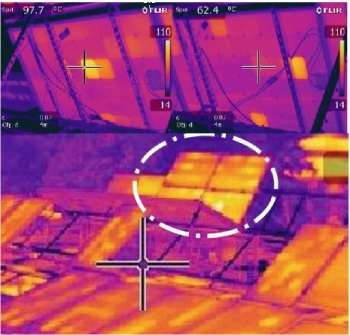Researcher Joshua Pearce from Michigan Technological University and colleagues from Queen’s University, Canada, have formulated a method to ensure a maximum amount of sunlight reaches solar panels so as to increase the yield by 30% or more.
 Thermal radiation readings on panels help Joshua Pearce and his research team better understand ways to improve low-concentration photovoltaic systems.
Thermal radiation readings on panels help Joshua Pearce and his research team better understand ways to improve low-concentration photovoltaic systems.
“We’re looking at this from a systems perspective,” Pearce, associate professor of materials science and engineering and electrical and computing engineering. Instead of looking at individual panels, the team chose to study the system. This was because the currently used ground-mounted solar panel arrays were not utilizing space well.
Large-scale utility solar farms make use of conventional flat-faced solar panels, which are installed with spacing between each panel so as to prevent shading. But when the sun shines on the photovoltaic system, a portion of it is lost as it goes through the spacing between the panels and reaches the ground.
Pearce offers a simple solution to this issue. He recommends using reflectors in the spaces to bounce sunlight back onto the panels.
“Panels are usually warranted for 20 to 30 years,” Pearce says, explaining that the warranty can be assured only under specific circumstances. “If you’re putting more sunlight on the panel with a reflector, you will have greater temperature swings and non-uniform illumination, but simple optics makes wrong predictions on the effect.”
At the moment, using reflectors nullify warranties for solar farm operators due to the ambiguity regarding probable hot spots. Pearce and the team devised a way to estimate the effects with the aid of bi-directional reflectance function (BDRF). BDRF is a set of math equations mainly used in the field of videogames and movies to develop computer generated imagery (CGI) characters and scenes that are life-like.
BDRF is a successful solution as the equations are capable of depicting the manner in which light is reflected off uneven surfaces, and estimating the way the light will disperse, forming indirect shadows and brightening.
The BDRF model built by the team for its solar panel research was capable of estimating the amount of sunlight that would get reflected off an individual reflector, as well as the location on the array where it would shine.
“Real surfaces do not necessarily behave like perfect mirrors, even if they look like it,” Pearce says. “So we applied [BDRF] models to these materials, which scatter the light instead.”
Providing information about how the reflectors scatter light will help remove the risk of using reflectors alongside the solar panels. The reflectors can now be used to significantly increase the output of the solar arrays.
“The mathematics behind this is complicated,” Pearce says, explaining that the team wanted to “validate the predictive model, so the solar industry could start using our equations to design better solar farms.”
The team tested the model in real situations at the Open Solar Outdoors Testing Field in Kingston, Ontario. The results of this experiment provided more information than expected.
There was an increase in efficiency of up to 45% for standard panels that were not tilted at an optimum angle for the latitude, and an increase of 18% even for optimally tilted panels. Simulations revealed that the efficiency could be further increased to 30% with the use of high quality reflectors.
“We expend a lot of blood, sweat and tears to make solar panels as efficient as possible,” Pearce says. “We work so hard to get a fraction of a percent increase on the module level; double digit returns on the systems level was relatively easy.”
This level of efficiency in photovoltaic systems could alter the way solar panels are fitted, and the economic benefit is likely to lead to retrofits for existing solar farms.
“Solar farms are already beating antiquated coal technology on cost all over the US,” Pearce says. “There are more solar workers than coal workers now as both in the U.S. and Canada, coal plants are being shut down for cheaper and more environmentally-friendly solar. This just offers to sweeten the economic returns for solar farm investors.”
“The main goal here was to hand the solar farm developers the data needed on a silver platter, which they can then use to modify their farms and crank up their output and revenue by about a third,” Pearce says.
The research findings were published in the Institute of Electrical and Electronics Engineers (IEEE) Journal of Photovoltaics.